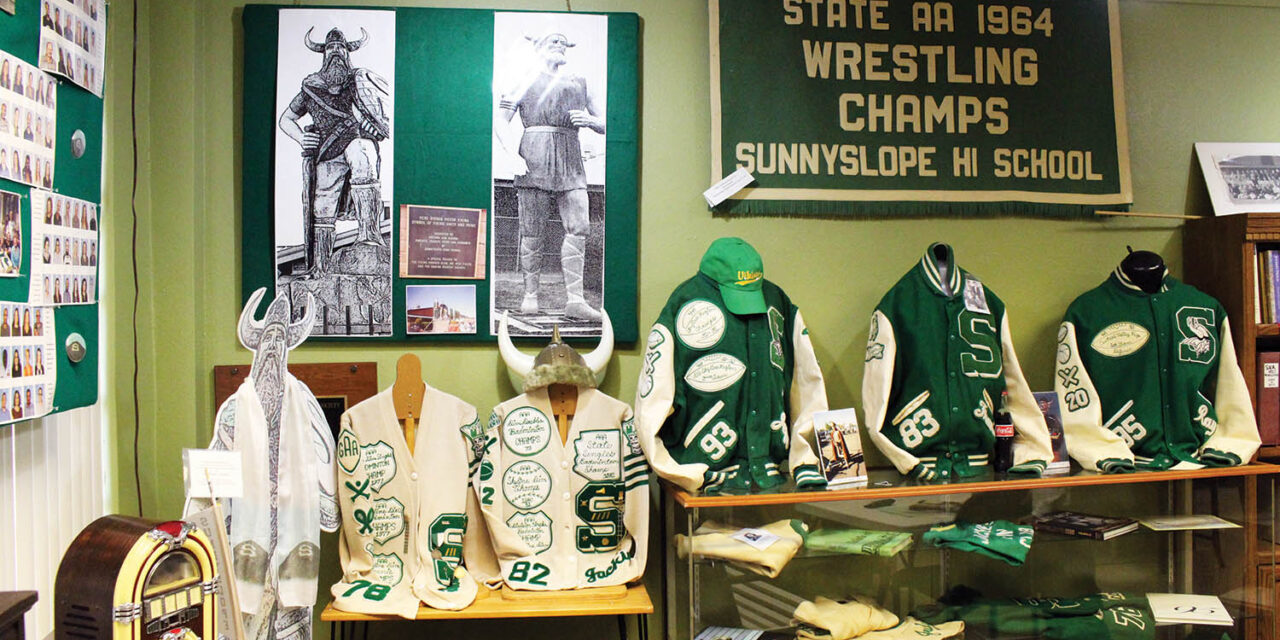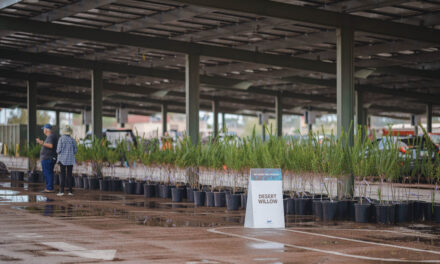
Memorabilia from decades of Sunnyslope High School activities is showcased in one of the exhibits at the Sunnyslope Historical Society and Museum (photo by Kathryn M. Miller).
Stepping over the threshold and into the ‘40s House, as it is called by the Sunnyslope Historical Society and Museum, is literally taking a step back in time.
The house was built in 1945 by Walter Leon Lovinggood at 8924 N. 2nd St., and kept in the family until it was sold in 1983. In 1999, the Society become the fourth owner of the house and it was moved to the current museum grounds to make way for a new shopping center. After its move, the home was immaculately restored — a labor of love that led to opening the house to the public in September 2012.
As the Society’s board president, Pat Wilkinson, leads a tour through the home, she points out some of the era-appropriate artifacts that are housed there. A radio/record player cabinet, dining set and furniture in the front room; a 1940s stove, ice box and beautiful cast iron/enamel sink and metal cabinets (complete with spice tins and food boxes from the ‘40s) in the kitchen; bedrooms full of furniture and clothes of the era, along with photos of the home, the area and other historical items — all collected by the museum or donated by residents over the years.
Across the breezeway from the home is the museum proper, which was formerly the People’s Drug Store, located at 111 E. Dunlap. It was moved at the same time as the ‘40s House. The museum houses a visual history of Sunnyslope from its early beginnings, a display that recreates the People’s Drug Store (complete with drive-through window), an archive room with more than a dozen file cabinets jam packed with area history and an extensive display showcasing the history of Sunnyslope High School and “S” Mountain. And if any Sunnyslope High School alums out there have a yearbook from 1975, 1992, 2000, 2003 or 2007 that they would part with, the museum would be happy to have it complete their collection.

From its turn of the last century homesteaders, the establishment of the Desert Mission in the late ‘20s, and its annexation by the City of Phoenix in 1959 to today, the Sunnyslope Historical Society and Museum says that preserving history and providing
a sense of place is important (photo by Kathryn M. Miller).
From its turn of the last century homesteaders, the establishment of the Desert Mission in the late ‘20s, and its annexation by the City of Phoenix in 1959 to today, Wilkinson emphasized that preserving history like this is important — not only as an educational tool for younger generations to understand what came before them, but to maintain a sense of place and find direction toward the future of Sunnyslope.
“Sunnyslope has a unique history,” Wilkinson said, “and a lot of people jump to the wrong conclusion. When you say Sunnyslope, you know, it’s all automatically, the drugs and the gangs…every community has that to a point nowadays… There are so many things that first started in Sunnyslope that people have no idea — the evaporative cooler was developed on Hatcher Road.”
She added, “Everything in these two buildings, if we didn’t have the museum, it would be gone. That’s history, and history has a tendency to repeat itself over generations. And it’s interesting to come in and find out: how did another generation live, how did they survive in the heat with 120-degree temperatures. You know, people today I think have it pretty easy, if you stop and consider what the earlier generations went through.”
As far as the future of Sunnyslope, “I’m a firm believer that your neighborhood is what you make it. If you want to improve it and change it, then get involved,” Wilkinson said.
In the meantime, residents can take a step back into the past at the Sunnyslope Historical Society and Museum, located at 737 E. Hatcher Road. In addition to tours, the museum offers educational events throughout the month, including “The Golden Age of Radio” presented by Thomas Mihalchick with the House of Broadcasting, Saturday, March 18, at 10 a.m
For information on hours and upcoming events, call 602-331-3150 or visit http://sunnyslopehistoricalsociety.org.










































